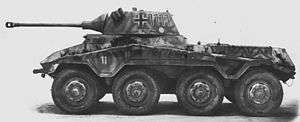SdKfz 234
| SdKfz 234/2 | |
|---|---|
|
Wartime side view of a SdKfz 234/2 Puma | |
| Type | Armoured car |
| Place of origin | Nazi Germany |
| Specifications | |
| Weight | 10,500 kg (23,148 lb) |
| Length | 6.02 m (19 ft 9 in) |
| Width | 2.36 m (7 ft 9 in) |
| Height | 2.10 m (6 ft 10 in) |
| Crew | 4 |
|
| |
| Armor | 9-30 mm (.35-1.18 in) |
Main armament |
•(234/2) 1x50 mm (2.0 in) L/60 KwK 39/1[1] •(234/1) 1x20 mm (0.79 in) autocannon •(234/3) 1x 75mm KwK 37 |
Secondary armament | 1x7.92 mm (0.312 in) machinegun |
| Engine |
14,825 cc (905 in3) Tatra 103[2] V12 diesel 157 kW (210 hp) |
| Suspension | wheeled |
Operational range | 1,000 km (625 mi) |
| Speed | 90 km/h (55 mph) |
The Sd.Kfz. 234 (Sonderkraftfahrzeug 234, or Special Purpose Vehicle 234), was a family of armoured cars designed and built in Germany during World War II. The vehicles were lightly armoured, armed with a 20, 50 or 75 mm main gun, and powered by a Tatra V12 diesel engine.[3] The Sd.Kfz. 234 broadly resembles the appearance of Sd.Kfz. 231 (8 rad).[4]
Development
Armoured wheeled vehicles were developed early in Germany, since they were not subject to the restrictions of the Versailles Treaty. The Sd.Kfz. 234 belonged to the ARK series (type designation of the chassis) and was the successor to the earlier Sd.Kfz. 231/232/233 (8-Rad), which belonged to the GS series.
The combat experience of fast-moving, hard-hitting wheeled reconnaissance vehicles during the Wehrmacht's early invasions of Poland and France impressed German military officials, but indicated some deficiencies in existing designs. A new armoured car project was thus undertaken in August 1940, incorporating several lessons from the Wehrmacht's own external operations.[5] The latest Büssing-NAG Sd.Kfz. 232 variant, the Sd.Kfz. 234 was designed later that year.[6] It was to have a monocoque chassis with eight wheels, and an air-cooled engine for use in North Africa.[7]
Chassis were built by Büssing-NAG in Leipzig-Wahren, while armoured bodies were provided by Deutsche Edelstahlwerke of Krefeld and turrets by Daimler Benz in Berlin-Marienfelde and Schichau of Elbing, with engines from Ringhoffer-Tatra-Werke AG of Nesseldorf.[8]
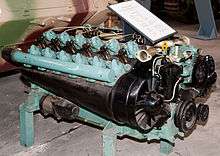
The vehicle had eight-wheel steering and was able to quickly change direction thanks to a second, rear-facing, driver's seat; the transmission had six forward and reverse gears, with traction over the eight wheels. Power was provided by an air-cooled Tatra 103 diesel engine.
The first and possibly best known version was the Sd.Kfz. 234/2; it had a turret armed with a 5cm L/60 gun, which was originally intended for the VK 1602 Leopard light tank. It was produced from late 1943 to mid 1944. This variant was replaced in production by the second version, the Sd.Kfz. 234/1, which had a simpler open turret (Hängelafette 38)[9] armed with a 2 cm KwK 38 gun; it was manufactured from mid 1944 to early 1945.
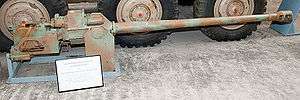
The SdKfz 234/3, produced simultaneously with the 234/1, served as a support vehicle for the reconnaissance vehicles. It had an open-topped superstructure, in which a short-barreled 7.5cm K51 L/24 gun was installed. This gun was intended for use against "soft" targets; however, when using a hollow charge shell, the penetration power exceeded that of the 5cm L/60 gun. This variant was produced from mid 1944 to the end of 1944, before switching production to the 234/4.
The final variant produced was the Sd.Kfz. 234/4, which replaced the L/24 gun with the 7.5cm L/46 PaK 40. This was yet another attempt to increase the mobility of this anti-tank gun; however, the 234 chassis was stretched to its limits, and it carried limited ammunition (twelve rounds) due to lack of storage space. This variant was manufactured from the end of 1944 to the end of hostilities in 1945.
Service history
Protracted engine development meant that the desert campaign was over before the 234 arrived, but it nevertheless proved useful on the Eastern and Western Fronts.[10] It was quite formidable, but not many were built before it was replaced by the simpler 234/1, with a 20mm gun, in 1944.[11]
Some sources suggest that the SdKfz 234/2 was used by the following combat units:[12]
- Panzer Lehr Division - 25 vehicles
- 2nd Panzer Division - 25 vehicles
- 1st SS Panzer Division - 16 vehicles
- 12th SS Panzer Division - 16 vehicles
- 20th Panzer Division - 16 vehicles
- 7th Panzer Division - 6 vehicles
- 13th Panzer Division - number unknown
Variants
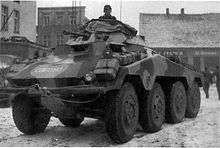
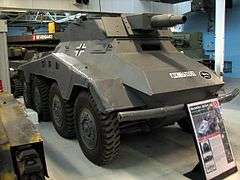
There were four main variants:
- 234/1 - 1 x 2 cm KwK 38 L/55 autocannon, 1 x MG 34 machine gun. This design featured an open-topped turret. Around 200 were produced.[5]
- 234/2 - 1 x 5 cm KwK 39 L/60 gun, 1 x MG 34 machine gun. Employed a fully enclosed turret originally designed for the VK 1602 Leopard light tank. The turret front was protected by 30 mm armor set at an angle of 20° from the vertical. The sides and rear had 10 mm armor set at 25°, and the top plate was 10 mm armor. The gun mantlet was rounded and was 40 to 100 mm thick. 101 were produced between September 1943 and September 1944.[5]
- 234/3 - 1 x 7.5 cm K51 L/24 gun in open-topped superstructure replacing the turret. 88 built between June and December 1944.[13]
- 234/4 "Pakwagen" - 1 x 7.5 cm PaK 40 L/46 gun in open-topped superstructure replacing the turret. 89 built between December 1944 and March 1945.[14]
References
Notes
- ↑ Hogg, Ian V. Greenhill Armoured Fighting Vehicles Data Book (London: Greenhill Books, 2000), p.221, "SdKfz 234/2".
- ↑ Hogg, p.221, "Sd Kfz 234/2".
- ↑ Fletcher, David. Hup, Two - Three - Four. Classic Military Vehicle, 2001, Volume 1 Issue 4 p. 48-51.
- ↑ Hogg, p.221, "SdKfz 234/2".
- 1 2 3 Green, Michael. Anderson, Thomas. Schulz, Frank. German Tanks of World War II. Zenith Imprint, 2000.ISBN 9780760306710
- ↑ Hogg and Weeks, p.185, "SdKfz 232, 233, and 234 (8 rad) Armoured Cars".
- ↑ Hogg and Weeks, p.185, "SdKfz 232, 233, and 234 (8 rad) Armoured Cars".
- ↑ Hogg and Weeks, p.185, "SdKfz 232, 233, and 234 (8 rad) Armoured Cars".
- ↑ panzernot.net, Sd Kfz 234/2 - The Sd Kfz 234
- ↑ Hogg and Weeks, p.185, "SdKfz 232, 233, and 234 (8 rad) Armoured Cars".
- ↑ Hogg, p.221, "Sd Kfz 234/2" & "Sd Kfz 234/1".
- ↑ Jentz, cited in "panzernot.net" website
- ↑ Hogg, p.221, "Sd Kfz 234/2".
- ↑ Hogg, p.221, "Sd Kfz 234/2".
Sources
- Hogg, Ian V. Greenhill Armoured Fighting Vehicles Data Book, p.221, "Sd Kfz 234/1", "Sd Kfz 234/2", "Sd Kfz 234/3", & "Sd Kfz 234/4". London: Greenhill Books, 2000. ISBN 1-85367-391-9.
- Hogg, Ian V., and Weeks, John. Illustrated Encyclopedia of Military Vehicles, p.185, "SdKfz 232, 233, and 234 (8 rad) Armoured Cars". London: Hamlyn, 1980. ISBN 0-600-33195-4.
- "s. Pz. Sp. Wg. (5 cm) Sd. Kfz. 234/2: German 8-Wheeled Armored Car", Catalog of Enemy Ordnance, U.S. Office of Chief of Ordnance, 1945.
Further reading
- Chamberlain, P.; Doyle, H. L. (1978). Encyclopedia of German Tanks of World War Two. A complete illustrated history of German battle tanks, armoured cars, self-propelled guns and semi-tracked vehicles, 1933—1945. London: Arms and Armour Press. ISBN 0-85368-202-X.
- Jentz, T. L.; Doyle, H. L. (2001). Panzerspähwagen. Armored Cars. Sd.Kfz.3 to Sd.Kfz.263. Panzer Tracts № 13. Boyds, MD: Panzer Tracts. ISBN 0-97084-074-8.
- Jentz, Thomas L. Schwerer Panzerspähwagen (Sd. Kfz. 234). Museum Ordnance Special Number 24. Darlignton Publications.
- Ledwoch, Janusz (1997). Samochody pancerne (8x8). Militaria № 41 (in Polish). Warsaw: Wydawnictwo Militaria. ISBN 83-86209-89-5.
- Spielberger, Walter J. (2008). Armored Vehicles of the German Army, 1905-1945. Spielberger German Armor & Military Vehicles Series. Schiffer Publishing. ISBN 978-0764329418.
